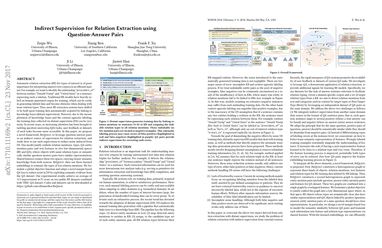Indirect Supervision for Relation Extraction using Question-Answer Pairs
Automatic relation extraction (RE) for types of interest is of great importance for interpreting massive text corpora in an efficient manner. Traditional RE models have heavily relied on human-annotated corpus for training, which can be costly in generating labeled data and become obstacles when dealing with more relation types. Thus, more RE extraction systems have shifted to be built upon training data automatically acquired by linking to knowledge bases (distant supervision). However, due to the incompleteness of knowledge bases and the context-agnostic labeling, the training data collected via distant supervision (DS) can be very noisy. In recent years, as increasing attention has been brought to tackling question-answering (QA) tasks, user feedback or datasets of such tasks become more accessible. In this paper, we propose a novel framework, ReQuest, to leverage question-answer pairs as an indirect source of supervision for relation extraction, and study how to use such supervision to reduce noise induced from DS. Our model jointly embeds relation mentions, types, QA entity mention pairs and text features in two low-dimensional spaces (RE and QA), where objects with same relation types or semantically similar question-answer pairs have similar representations. Shared features connect these two spaces, carrying clearer semantic knowledge from both sources. ReQuest, then use these learned embeddings to estimate the types of test relation mentions. We formulate a global objective function and adopt a novel margin-based QA loss to reduce noise in DS by exploiting semantic evidence from the QA dataset. Our experimental results achieve an average of 11% improvement in F1 score on two public RE datasets combined with TREC QA dataset.
PDF Abstract



 TrecQA
TrecQA